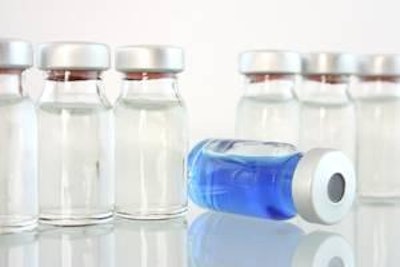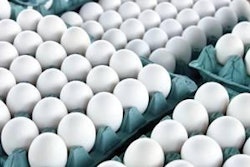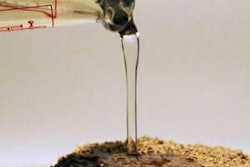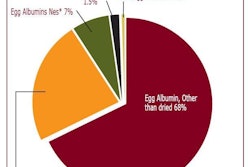
The benefits of early, hatchery vaccination in terms of subsequent bird health and quality are well known and have led to a wide adoption of this approach in recent decades.
However, the same environment that is ideal for incubating eggs is also optimal for the incubation of pathogenic bacteria, viruses and fungi, so good hygiene is a critical success factor for any hatchery. Vaccination can provide a potential route of entry for pathogens into the egg or chick and requires even more stringent control of sanitation if the hatchery is to produce top quality chicks for its customers.
Egg cleanliness
Hatchery hygiene begins at the breeder farm. As eggs are laid they are quickly challenged by microbes found on the floor, litter, droppings and possibly a dirty egg belt, all of which can contaminate the shell. Transfer of eggs to contaminated flats, trays or cartons, possibly by unsanitized hands, adds to the microbial load on eggs, as can the storage room and transport to deliver them to the hatchery.
If transfer to the hatchery is not entirely smooth, then there is the added possibility of eggs being cracked and microbes accessing the ideal growth medium inside. Finally, there is the possibility of contamination from rodents, birds, flies and other insects.
Eggs should arrive at the hatchery in the best possible condition. Temperature control during this process and during storage (both on the farm and in the hatchery) is critical as changes in temperature can make the eggs sweat and increase the risk of bacteria replicating and getting through the shell. Storage should be in a cool (20C), clean and disinfected area.
The aim is to incubate eggs with minimal microbial contamination on the surface, especially if the eggs are to be vaccinated in ovo.
Vaccine preparation
Contaminated vaccine can be the cause of reduced hatchability and increased chick mortality. Vaccines labelled for administration by in ovo, subcutaneously or intramuscularly must be sterile in order to avoid introducing pathogens into the egg or bird. They must also have been stored and prepared correctly in order to optimize the level of protection.
If both in ovo and day-of-hatch vaccines are being administered, then each should have its own separate storage and preparation area to avoid accidentally giving vaccine by the wrong route.
The preparation environment is a potential source of vaccine contamination and care should be taken when preparing vaccine batches. This area should have no through traffic and only designated personnel should be allowed in.
The usual hygiene precautions should be taken:
- Wash and dry hands thoroughly before each session
- Wear safety goggles and gloves
- Spray and wipe down the vaccine preparation working surface with alcohol prior to each session
- Use a separate syringe and needle for each constituent, use them once only, and use the correct size (18 g 3.6cm needle, 20cm3 syringe)
- Swab all needle entry points with alcohol before inserting needles
- Dry ampoules and hands thoroughly with clean paper towels prior to opening vials
- Never touch needles with fingers
- Stick to a defined daily, weekly and monthly cleaning schedule for the vaccine preparation area
The thaw bath is a common source of contamination and should be clean and dry during storage and before use. It should be filled with distilled water; never tap water. A sterile ladle of some kind should be used to remove ampoules from the bath, rather than hands. Alternatively, chlorine 200 ppm (15 mL of 5.0% bleach per gallon) can be added to the bath; the same can be added to the ice bath for chilling the mixed vaccine.
If any mistakes are made during preparation, or there is any question over the correct preparation, then discard those elements, including vaccine if relevant. A common mistake is overflow of the ampoule during rinsing: if this happens discard the rinse diluent, needle/syringe and empty ampoules immediately. Do not add diluent rinse to the vaccine bag if overflow occurs during the rinse procedure.
Finally, it is essential to keep accurate records of vaccine and diluent serial numbers and details of preparation sessions, including dates, times, personnel and the final usage of the vaccine.
Vaccination procedure
Aseptic vaccine preparation is probably the most critical factor for in ovo vaccines. However, the procedure itself is also a key management point. The same level of care should be taken when connecting vaccine bags to in ovo machines, and start up and shut down procedures should be followed exactly as detailed in the manufacturer’s guide.
When the machine is shut down, all containers should be cleaned (alcohol, sanitizer, cleaner, distilled water) and dried upside down overnight. Special attention should be paid to drip pans, injection tooling and vacuum cups on the transfer head.
If vaccine is to be delivered by subcutaneous or intramuscular injection at day of hatch using an automated vaccinator, equipment must be sanitized before the procedure starts. The diluted vaccine should be connected and the system checked for correct delivery before the session is started. Needles should be replaced after every 1,000 chicks and immediately if they become blunt or bent. Equipment must be correctly and thoroughly cleaned, sanitised and maintained at the end of each vaccinating day.
Day-of-hatch vaccines should be used within 45 minutes of being reconstituted.
If vaccines are to be administered by spray, the water used for vaccine reconstitution should be distilled and at room temperature (22C). Warm water could have a negative impact on vaccine viability and cold water may chill the chicks.
Sanitation plan
All hatcheries should have a documented sanitation plan. Hygiene and sanitation should be the subject of standard operating procedures, and these should include measures aimed at the preparation and administration of vaccine, irrespective of the route of administration.
On-going assessment of the microbial challenge within the hatchery is also essential for benchmarking and improving hygiene. High levels of fungi, such as Aspergillus, generally indicate a problem with sanitation, maintenance and/or design of the hatchery ventilation system.
The future is likely to see ever more hatcheries applying in ovo or day-of-hatch vaccination. If these hatcheries can maintain a suitable sanitation program, including vaccine preparation and use, then bird health can be improved.

















